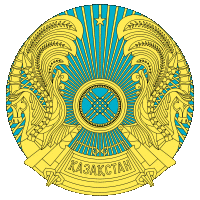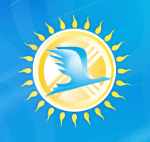QMS
QMS
Virtual technologies
Virtual technologies
History
|
History. Karaganda economic university was formed almost half a century ago and was well known and respected throughout the former Soviet Union. Among people our University used to have a well-deserved reputation of the best university in preparing skilled specialists for the Soviet consumer cooperatives, so people affectionately called him "Koper". Moreover KEUK trained qualified personnel not only for Kazakhstan, but also for the countries of Central Asia and Russia. A new stage in the life of the university began with Kazakhstan's independence. The sovereignty of our country opened endless possibilities for a good development. The basis was taken from the experiences of leading, most prestigious private universities in the world - Oxford, the Sorbonne and Harvard. In a short time stuff headed by rector of the university doctor, professor Erkara Aimagambetov managed the most important thing - to create a team of confederate professionals and a strong material-technical base, as experts mention, in the level of international standards. Our days. Today, according to the latest researches, KEUK is among the three leading humanitarian and economic universities of the country. In Central Kazakhstan it is first specialized economic university, which prepares highly qualified specialists in the field of economics and law in 21 specialties. Our graduates are in demand in a various fields of a rapidly developing economy of Kazakhstan. Because, the main mission of the Karaganda Economic University of Kazpotrebsoyuz is "Education for growth and personal development!". The main defining feature of KEUK today is its innovative activity and outrunning character development of educational technologies. In this continuous process actively participate the scientists of the University. Today there are more than 350 teachers, more than half have different degrees. Only during the past academic year nine thirty-nine teachers have been trained in the most prestigious universities in the world. Innovations. Today in the university is implemented the scientific and innovative mega project "Electronic university". It will increase the competitiveness of the university in the context of globalization and helps successfully integrate into the world educational space. KEUK experts have already started the final phase of creating a single informational space and efficient communicational infrastructure. International activity. In recent years, KEUK pays special attention to the development of international cooperation. KEUK became one of the few universities of Kazakhstan which signed the Magna Charta of European Universities. The mutual cooperation with more than 50 universities from 14 countries is established. According to various international programs the best university students do lots of internships abroad. University policy today - continuous work on supporting and improving the image of the university both on the part of consumers of educational service, as well as corporate world and the state; - continuous increase of all university processes according to requirements of the international standard ISO 9001:2008; - implementation of innovations including innovative educational technologies; - forming high informational and communicational culture; - the study of cultural heritage of Kazakhstan. |
|
State symbols of the Republic Kazakhstan
The Flag of the Republic of Kazakhstan
 Flag– Flag is one of the main symbols of the state that represents its sovereignty and identity. The Russian term "flag" for Flag comes from the Dutch word "vlag" and means cloth of officially adopted size and colour and commonly with an image of emblem (coat of arms).
Flag– Flag is one of the main symbols of the state that represents its sovereignty and identity. The Russian term "flag" for Flag comes from the Dutch word "vlag" and means cloth of officially adopted size and colour and commonly with an image of emblem (coat of arms).
The Flag of sovereign Kazakhstan was officially adopted in 1992. It was designed by Shaken Niyazbekov.
The State Flag of the Republic of Kazakhstan is a rectangular breadth of blue colour with the image of the sun in its center with a soaring steppe eagle underneath. Along the flagstaff there is a vertical band with the national ornamental patterns. The images of the sun, rays, eagle and ornament are of golden colour. The ratio of the Flag's width to its length: 1:2.
In heraldry each colour has its own specific meaning. Thus, a blue-sky colour symbolizes honesty, fidelity and integrity. Moreover, the blue-sky colour has a deep symbolic meaning in Turkic culture. The ancient Turkic peoples always worship the According to the heraldic principles the sun symbolizes wealth and abundance, life and energy. That is why the sun rays on the flag have the form of grain, a symbol of wealth and welfare. By representing the sun at its state attributes Kazakhstan reaffirms its commitment to universal values, which also indicates that the new young country is full of life-affirming energy and is open to all countries for cooperation.
The image of the steppe eagle is one of the main heraldic attributes which is used on coat of arms and flags of various peoples for centuries. This image is commonly considered as a symbol of power, insight and generosity. A soaring steppe eagle represents by itself a power of the state, its sovereignty and independence, aspiration to high goals and sustainable future. The image of the steppe eagle on the world outlook of Eurasian nomads has a special place and is associated with such notions as freedom and fidelity, sense of dignity and courage, strength and purity of thoughts. The symbolically rendered silhouette of the golden steppe eagle reflects aspiration of the young sovereign state to the heights of world civilization.
Another important element of the State Flag is a vertical band with the national ornamental patterns. This Kazakh ornament is one of the forms of specific artistic perception of world in strict accordance with aesthetic styles of the people. Representing a harmony of various forms and lines, it is also an expressive means of discovery of the inner world of the people. The national ornament along the flagstaff represents the art and cultural traditions of the people of Kazakhstan.
The Emblem of the Republic of Kazakhstan

The Emblem– is one of the main symbols of the state. The Russian term "gerb" for Emblem comes from the German word "Erbe" (legacy) and means hereditary distinctive sign that represents a combination of figures and objects to which a symbolic sense reflecting cultural and historical traditions of the state is given.
The history is an evidence of the fact that the nomads of the Bronze Age that inhabited the territory of modern Kazakhstan identified themselves with a special symbol which is called totem. Its graphical expression further got the name "tamga". This term has been for the first time used in the Turkic Khaganate.
The Emblem of the sovereign Kazakhstan was officially adopted in 1992. The authors of the State Emblem are Kazakhstan's famous architects Zhandarbek Malibekov and Shot-Aman Ualikhanov.
The State Emblem of the Republic of Kazakhstan has the shape of a circle (wheel). It is a symbol of life and eternity that was especially valued among the nomads of the Great Steppes.
The central heraldic element of the State Emblem is the image of shanyrak (an arched cross-shaped top of the Kazakh yurt) against a sky blue background which irradiates uyks (supports or bearings of the yurt) in the form of sunrays to all sides. On both right and left of shanyrak there are images of mythical winged quarter horses. At the top of Emblem there is a volumetric five-pointed star. There is also the inscription "Kazakhstan" at the bottom of the Emblem. The images of shanyrak, uyks, and mythical horses, as well as the inscriptions "Kazakhstan", have the colour of gold.
Shanyrak is a main backbone part of the yurt that resembles a blue sky. It is also one of the key elements of Kazakh family dwelling in the traditional culture of Eurasian nomads. The image of shanyrak on the State Emblem of the republic is a symbol of common home and common homeland of all people living in Kazakhstan. The stable development of Kazakhstan depends on welfare of each citizen just like the strength and stability of shanyrak depends on reliability of all its uyks.
The winged mythical horses, tulpars, are the key heraldic element of the State Emblem. The image of the horse stands for such notions as bravery since time immemorial. The wings symbolize a centuries-old dream of multinational people of Kazakhstan to build a strong and prosperous nation. They represent pure thoughts and aspiration to successive and constructive development. The golden wings of racers also resemble golden sheaves of grain that are a sign of labor of the people of Kazakhstan and material welfare of the country.
In centuries past the horns are often used during ceremonial rites of nomads as well as a finial to their fighting banners. The images of heavenly grace, fertility of the earth and the military fortune in the form of various animals' horns are always considered as integral parts in symbolic compositions of different peoples. Therefore, a winged horse with a horn of plenty is an important typological image which has deep semantic and historical roots.
Another element on the coat of arms is a five-pointed star. This symbol is used by man from ancient times and represents constant aspiration of people to the light of truth and the pursuit of the sublime and eternal matter. The image of a star on the State Emblem reflects the dream of people to build a state open to all countries of the world for cooperation and partnership. Hearts and arms of the people of Kazakhstan are open to representatives from all five continents.
The primary colour of the State Emblem is the colour of gold, which serves as a symbol of wealth, justice and magnanimity. The colour of blue sky symbolizes a serene sky, peace and prosperity.
National Anthem of the Republic of Kazakhstan
The Anthem is one of the main symbols of the state. The Russian term gimn for Anthem comes from the Greek word Gimneo and means solemn, ceremonial song. The Anthem serves as an important sound symbol with a key value for the effective socio-political consolidation and ethnocultural identification of citizens of the country. In the history of sovereign Kazakhstan the national anthem was adopted two times: in 1992 and 2006..
The new State Anthem was adopted in 2006 in order to promote the countrys sound symbolism. It is based on the patriotic song Menyn Kazakhstanym (My Kazakhstan) which is popular among the people and written in 1956, with music by Shamshi Kaldayakov and lyrics by Zhumeken Nazhimedenov. President Nursultan Nazarbayev modified the original lyrics of the song. The corresponding amendments have been introduced to the Decree On State Symbols at the joint session of the Houses of Parliament on January 6, 2006 and the Parliament approved it as a new State Anthem of Kazakhstan.
Music by Shamshi Kaldayakov
Lyrics by Zhumeken Nazhimedenov and Nursultan Nazarbayev
Sky of golden sun,
Steppe of golden seed,
Legend of courage -
Take a look at my country!
From the antiquity
Our heroic glory emerged,
They did not give up their pride
My Kazakh people are strong!
Chorus:
My country, my country,
As your flower I will be planted,
As your song I will stream, my country!
My native land – My Kazakhstan!
The way was opened to the posterity
I have a vast land.
Its unity is proper,
I have an independent country.
It welcomed the time
Like an eternal friend,
Our country is happy,
Such is our country.
Chorus (twice)
KEUK. ABOUT US
| Karaganda Economic University was founded in 1966 as the Karaganda Cooperative Institute of Centrosoyuz and in 1997 after passing the state accreditation institution was renamed and received university status. In 2016, the university will be 50 years old. As one of the leading universities in Kazakhstan, KEU is working with the global environmental changes. The University is committed to offer modern and advanced educational program, to respond to external challenges timely and to lead changes that support the sustainable development of society. The main objective of the University is to provide high quality training to the needs of the dynamic development of economy and society. KEU is among the three leading humanitarian and economic universities of the country. University graduates are educated to become universal specialists who have high intellectual abilities that will allow them to be leaders of society, able to promote the social, cultural, economic and environmental interests of society. The University is part of several international associations: International Association of Universities, Magna Charta Universitatum, Association of Educational Institutions Educational Network (EdNet), the Council of the CIS cooperative universities, Law universities Association, the Association of Eurasian Economic Universities. In 2006 in Bologna (Italy) University signed the Magna Charta of European Universities. Today the university has 70 existing cooperation agreements with leading universities in 18 countries, including Russia, Ukraine, Italy, Spain, Austria, Germany, Poland, Bulgaria, Czech Republic, Romania, Hungary, South Korea, Turkey, China and Malaysia. As part of the University of Shanghai Cooperation Organization are realized 2 concerted educational master's programs of double-diploma education specialties "Economics" and IT-direction. The university has created and successfully operate the basic elements of research and innovation infrastructure of the University, which includes 2 Research Institutes (SRI of new economy and system analysis and SRI of economics and legal studies), 2 scientific offices (Office of business and technology incubator and the Office of commercialization and technology transfer), the main objective of which is aimed at creating favorable conditions for the implementation of scientific and innovative projects of students, undergraduates, doctoral students and the PPS of the university. |
|
KEU trip
KEU trip
KEUK video channel
UNТ
Unified National Testing (UNT)
Unified National Testing (UNT) is one of the forms of the final students' assessment in secondary schools, combined with the entrance exams.
UNT is conducted for:
- graduates who wish in the current academic year to go to the universities of Kazakhstan;
- applicants for the General Certificate of Secondary Education "Altyn Belgi" General Certificate of Secondary Education with honors;
- Winners of republican scientific competitions and olimpiads in general subjects of current year.
Applications submission for participation in the UNT from March 10 to April 25. The completion of application forms is done by the graduates in those schools in which they study.
NTC develops technologies, instructions and software for UNT. A state Commission are appointed aimed at organizing and conducting the UNT at each testing point. The control over compliance with the technology of the UNT is performed by the representatives of the Ministry.
UNT is held in 5 subjects including compulsory: Kazakh or Russian languages (language of instruction), mathematics, history of Kazakhstan, Kazakh language for Russian schools (Russian for Kazakh schools), and optional subject. UNT durationis 3,5 hours (210 minutes). Retesting is not allowed.
Testing is conducted on the tests developed by National Testing Center based on general education programs, their content cannot go beyond these programs.
Information disclosing the content of the tests and the codes of correct answers are of state secrets.
The number of tests in each subject is 25. The correct answer to each test item is evaluated as one grade.
Normative references:
Rules of conducting common national testing;
Instructions for the organization and conduct unified national testing.
Training test for prospective students.
Training test for prospective students.








